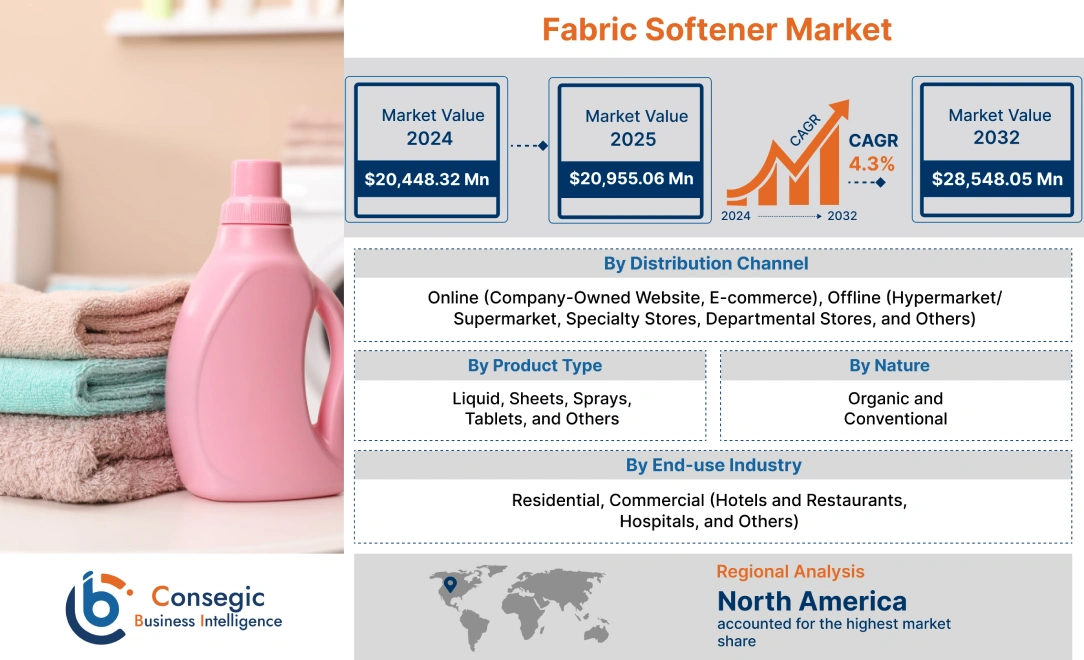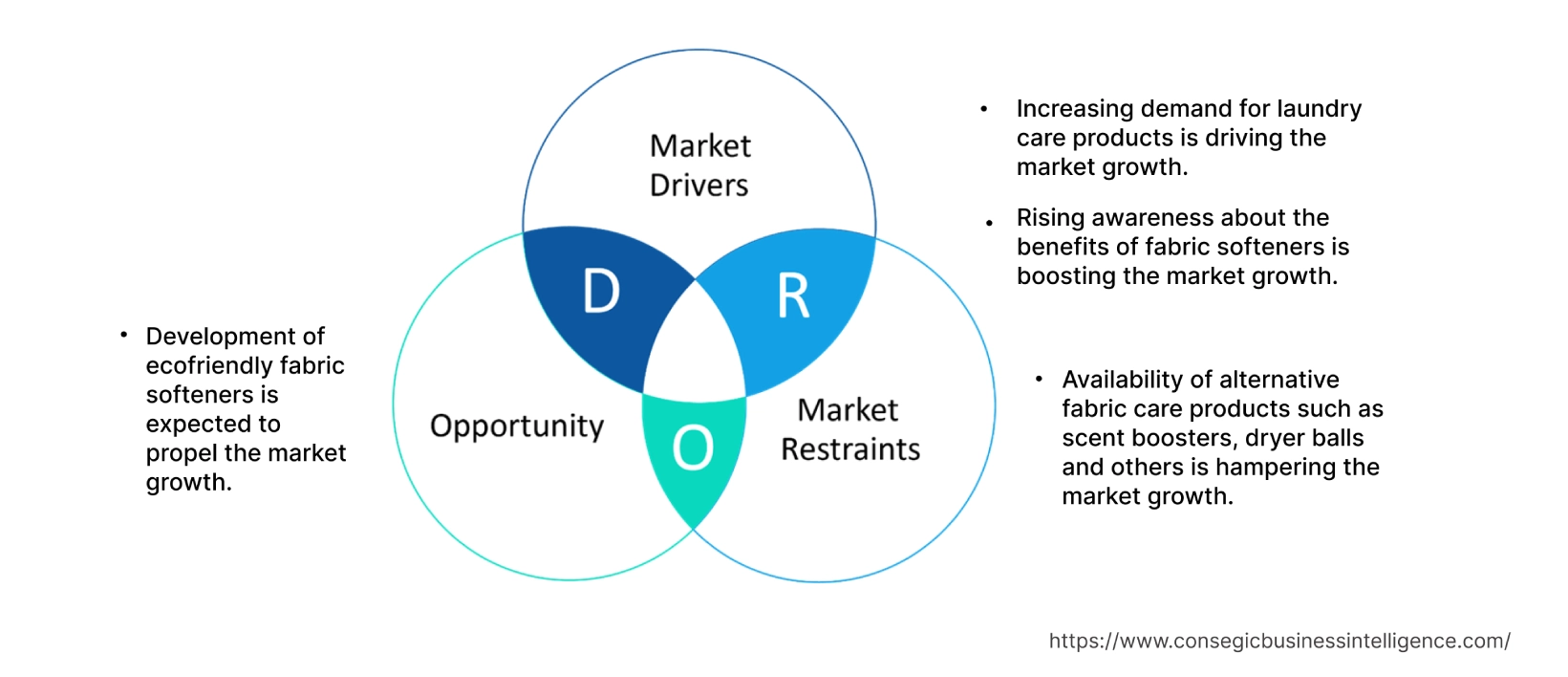Fabric Softener Market Size :
Consegic Business Intelligence analyzes that the Fabric Softener Market size is estimated to reach over USD 28,548.05 Million by 2032 from a value of USD 20,448.32 Million in 2024 and is projected to grow by USD 20,955.06 Million in 2025, growing at a CAGR of 4.30% from 2025 to 2032.
Fabric Softener Industry Scope & Overview :
Fabric softener is a product that is added to laundry to make clothes and other fabrics softer, reduce static cling, and add a fresh scent. It is typically added to the rinse cycle of a washing machine, but can also be applied to dry fabrics using a dryer sheet or spray. It works by coating the fibers of fabrics with a thin layer of chemicals. These chemicals lubricate the fibers and reduce friction, which makes the fabric feel softer and smoother. It also contain anti-static ingredients, which help to reduce static cling.
Fabric Softener Market Insights :
Fabric Softener Market Dynamics - (DRO) :
Key Drivers :
Increasing demand for laundry care products aids in market growth
Fabric softeners are considered laundry care products as they keep clothes free of wrinkles and protect the clothes from fading. Analysis of market trends concludes that the rise in demand for laundry care products to maintain personal hygiene is driving the growth of the market. Also, the rising population coupled with the growing working population has been leading to a increasing requirement for quick dry cleaning methods and laundry care products. Consumers are spending largely on laundry care products due to the adoption of a healthy lifestyle coupled with rising awareness for hygiene. Hence, there is a large requirement for the softeners as laundry care products in the residential sector, laundry services, hospitals and hotels, and others. They can be used on a variety of fabrics, including cotton, polyester, and wool. However, it is important to note that they can irritate sensitive skin and may build up on clothes over time, making them less absorbent.
Also, the introduction of different technologically enhanced laundry care products such as smart dispensing, washing machines with smart water technology, and others have been increasing the usage of the softener products. Hence, due to the aforementioned factors, the rising demand for laundry care products globally has been leading to significant fabric softener market demand.
Rising awareness about the benefits of fabric increase the consumer base
Increasing awareness about different benefits of fabric softeners such as improvement in absorbency, allowing clothes to dry faster, and saving energy and money on drying costs, among others is boosting the fabric softener market growth. Furthermore, the softener products combat wrinkles, reduce static, and add a fresh fragrance to the laundry. Also, the product adds elasticity to the fibers, reduces wrinkles, makes the clothes less stiff, and helps the clothes last longer. Also, they prevent the color from fading and fibers from any damage. Furthermore, the product makes the fabric feel bouncier and pleasant to touch. Analysis of market trends concludes that the growing awareness of fabric care among consumers for certain advantages such as wrinkle reduction, reduced fabric wear, and easy ironing, among others is stimulating the expansion of the market. Owing to consumers looking for products that are cost efficient, save time, and also meet cleaning and conditioning purposes, the market is growing significantly. Hence, due to the aforementioned factors, the softeners are being used largely by consumers across the globe.
Key Restraints :
Availability of alternative fabric care products such as scent boosters, dryer balls, and others bring the market down
The wide availability of substitutes for fabric softeners is hampering the growth of the fabric softener market. Substitutes such as scent boosters, dryer balls, and other conditioners are widely used in the market due to their specific advantages. The softeners are recommended to be avoided for those who have skin sensitivity and allergies. Dryer balls are highly allergy-friendly and add a slight softening effect as the product is found mainly in unscented, wood, or plastic forms. The dryer balls are widely used in jackets and help in removing the lumpiness after the wash. Hence, due to the aforementioned benefits, the availability of different alternative fabric care products is hampering the market expansion.
Future Opportunities :
Development of ecofriendly fabric creates new scope for market
The introduction of eco-friendly fabric softeners by the key players in the market is forecasted to boost the market proliferation. Hence, different manufacturers are focusing majorly on eco-friendly products such as plant based enzymes and mineral based surfactants. Consumers are also preferring eco-friendly and organic laundry care products that have minimal impact on the environment. Thus, different innovations and the launch of new products are serving as major opportunities for market growth. Analysis of market trends concludes that the development of eco-friendly products is emerging as one of many fabric softener market opportunities that will drive market expansion in the forecast years.
Fabric Softener Market Report Insights :
| Report Attributes | Report Details |
| Study Timeline | 2019-2032 |
| Market Size in 2032 | USD 28,548.05 Million |
| CAGR (2025-2032) | 4.3% |
| By Product Type | Liquid, Sheets, Sprays, Tablets, and Others |
| By Nature | Organic and Conventional |
| By End-use Industry | Residential, Commercial (Hotels and Restaurants, Hospitals, and Others) |
| By Distribution Channel | Online (Company-Owned Website, E-commerce), Offline (Hypermarket/Supermarket, Specialty Stores, Departmental Stores, and Others) |
| By Region | North America, Europe, Asia-Pacific, Latin America, and Middle East & Africa |
| Key Players | Unilever, AlEn USA LLC, Devan Chemicals, HENKEL AG & CO. KGaA, MARICO LTD., PIGEON CORPORATION, COLGATE PALMOLIVE COMPANY, RECKITT BENCKISER GROUP PLC., PROCTER & GAMBLE COMPANY, and Church & Dwight Co., Inc. |
Fabric Softener Market Segmental Analysis :
By Product Type :
The product type segment is categorized into liquid, sheets, sprays, tablets, and others. In 2024, the liquid segment accounted for the highest fabric softener market share of 57.28% in the market. Liquid softeners are widely utilized in the residential and commercial sectors as the product boosts the durability of clothes by reducing the movement of fibers within the yarn. Also, consumer preference for fully automatic washing machines over semi-automatic ones has been increasing the requirement for liquid softeners. This is due to the ability of the product to easily mix during the rinsing cycle of the washing machine. Hence there is high demand for the product in textile production, hospitality, laundry services, households, and others. Thus, due to the aforementioned factors, the liquid segment is experiencing significant fabric softener market growth.
Moreover, the sheets segment is expected to grow at the fastest CAGR over the forecast period in the fabric softener market. The sheets are useful in eliminating wrinkles and static, adding soothing fragrance, and keeping the clothes softer. They are pre-moistened sheets which are designed to be placed in the dryer. Also, the sheets are known for preserving the color and improving the longevity of clothes. Assessment of market trends indicates that new product launches by the key players in the market are boosting the proliferation of sheets segment. For instance, in June 2021, AlEn USA LLC expanded its product portfolio with new two products such as Ensueno Liquid Laundry Detergent and Ensueno Scent Booster Dryer Sheets. These products offer a complete laundry care solution and are available at selected retailers nationwide. Hence due to the aforementioned factors, the sheet segment is growing positively in the market.
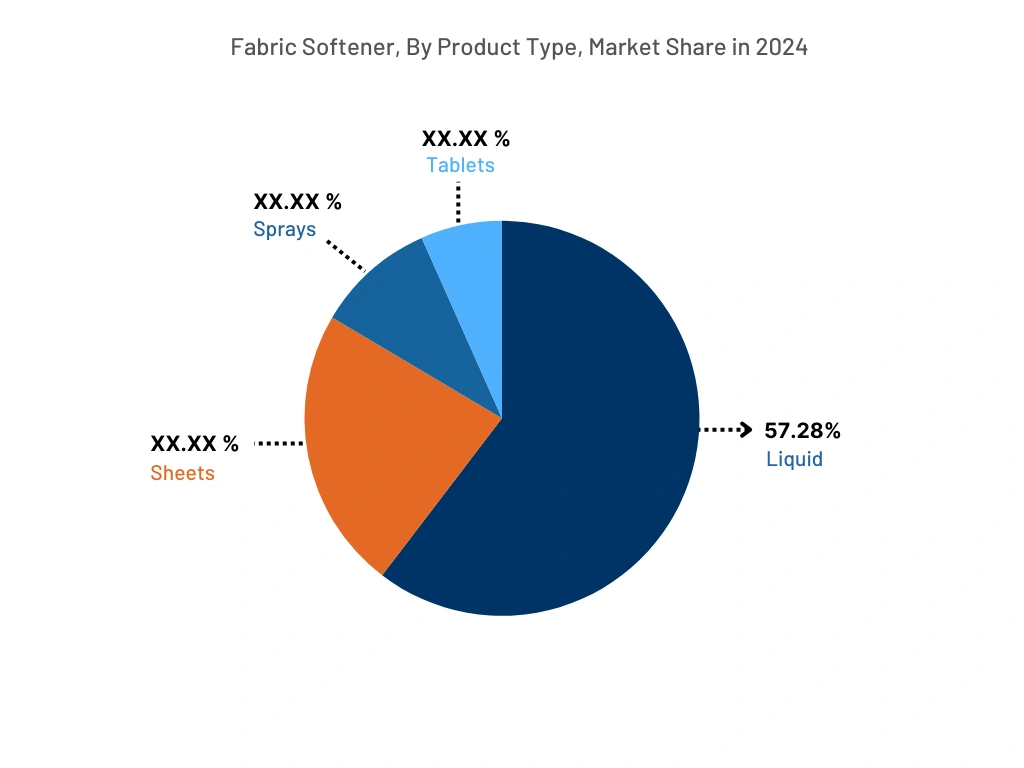
By Nature :
The nature segment is categorized into organic and conventional. In 2024, the organic segment accounted for the highest market share and is expected to grow at the fastest CAGR over the forecast period in the fabric softener market. Consumers are highly inclined to eco-friendly and organic laundry care products as the products have less impact on the environment. Also, various manufacturers in the market are focusing more on organic ingredients such as coconut oil, olive oil, and others in the products as they are efficient enough to not damage the hands of the washer and do not bleach out colors from the cloth. Assessment of market trends indicates that new product launches by the key players in the market have been boosting the proliferation of organic softener products. For instance, in May 2021, Devan Chemicals, a worldwide developer of specialty chemicals for textiles, launched a bio-based softener product that is derived from vegetable oils. Hence, new and innovative product launches in the market are driving the organic segment in the market.
By End-Use Industry :
The end-use industry segment is categorized into residential and commercial. The commercial segment is categorized into hotels and restaurants, hospitals, and others. In 2024, the commercial segment accounted for the highest market share in the fabric softener market. Owing to the usage of fresh and stain-free towels, bed sheets, and other products. Also, it is widely demanded in hotels and the textile production sector across the globe. Moreover, expansion in the textile and hospital sector globally is driving the expansion of the segment in the market. Assessment of market trends indicates that the increasing investment by different governments in expanding the healthcare infrastructure is driving the proliferation of the commercial segment. For instance, according to a recent report by India Brand Equity Foundation in 2023, the Indian government is planning to introduce a credit incentive program worth USD 6.8 billion to boost the country's healthcare infrastructure. Hence, due to the aforementioned factors, the commercial segment is witnessing significant fabric softener market growth.
Moreover, the residential segment is expected to grow at the fastest CAGR over the forecast period in the fabric softener market. Due to the necessity of for washing machines in urban areas, the softeners are widely demanded in different households. The product can be incorporated into automatic washing machines and thus increasing sales of automatic washing machines is increasing the growing requirement for the softeners. Also, increasing residential constructions and expansion of the real estate sector is proving to be a catalyst for the proliferation of market. Hence, due to the aforementioned factors, the residential segment is experiencing positive development and is forecasted to grow further in the forecast years.
By Distribution Channel :
The distribution channel segment is categorized into online (company-owned website, e-commerce), and offline (hypermarket/supermarket, specialty stores, departmental stores, and others). In 2024, the offline segment accounted for the highest market share in the fabric softener market. The offline segment has been showcasing major proliferation due to the time delivery of the product, personalized recommendations from the staff, wide variety to choose from on the spot, and shopping satisfaction. Consumers do get advised by the sales staff about the advantages of different product types of softeners so that the consumers can check the quality of the product on the spot and make a wise purchase decision accordingly. Analysis of fabric softener market trends concludes that the expansion of the softener and conditioner businesses in large retail outlets is acting as a catalyst for the proliferation of the offline segment. Hence, due to the aforementioned advantages of the offline distribution channel, this segment is foreseeing high segmental growth in the market.
Moreover, the online segment is expected to grow at the fastest CAGR in the overall fabric softener market during this forecast period. This is due to the rise in e-commerce platforms and increasing digitalization across the globe. Consumers prefer ease of shopping, and easy product returns, and thus online shopping is considered a time-saving approach. Analysis of fabric softener market trends concludes that the 24*7 access to the product lines by the customers acts as a catalyst for the expansion of the online segment. Hence, due to the mentioned advantages of online distribution channel, the segment in the market is growing significantly.
By Region :
The regional segment includes North America, Europe, Asia Pacific, the Middle East and Africa, and Latin America.
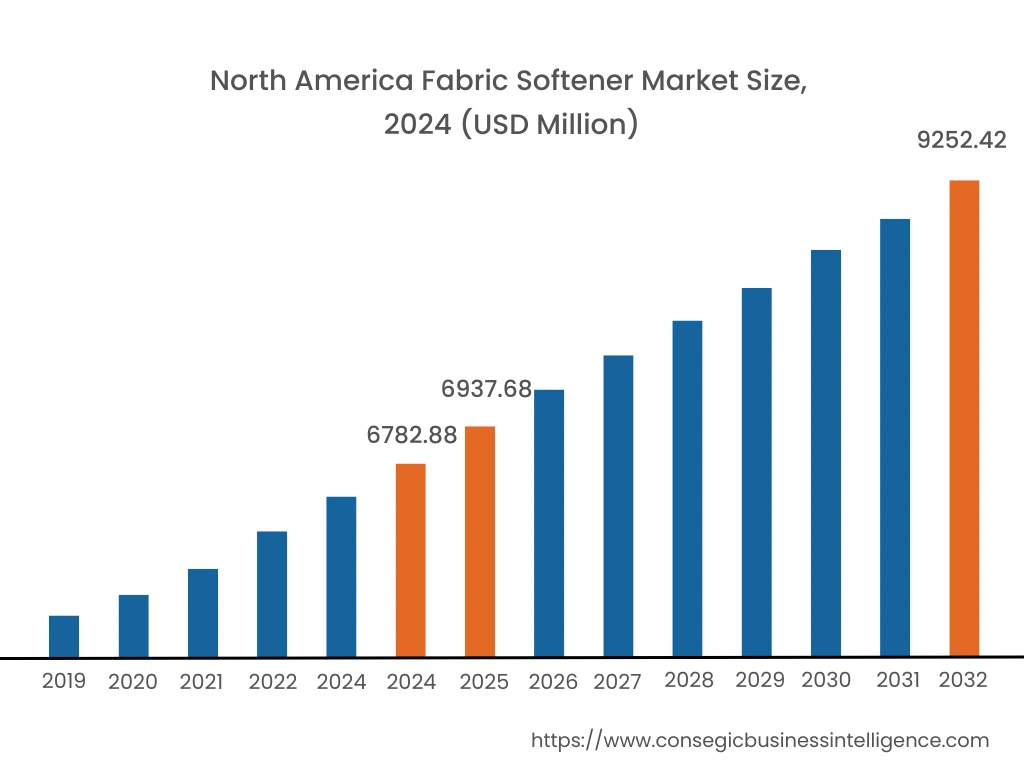
North America is estimated to reach over USD 9,252.42 Million by 2032 from a value of USD 6,782.88 Million in 2024 and is projected to grow by USD 6,937.68 Million in 2025. In North America, the U.S. accounted for the highest market share of 89.30% during the base year 2024. Owing to the large working population coupled with the high disposable income of the consumers in the region. Furthermore, the high living standard of consumers coupled with the presence of major market players in the region, the market is growing significantly in North America. The fabric softener market analysis concluded that the increasing laundry and textile industry in the region is significantly impacting the market proliferation.
Moreover, Asia Pacific is expected to witness significant growth over the forecast period, growing at a CAGR of 5.1% during 2025-2032. Increasing urbanization coupled with a rise in population in the region is leading to the growing adoption of fabric softeners in the Asia Pacific. The fabric softener market analysis concluded that the adoption of a healthy lifestyle coupled with rising concern for hygiene is driving the market expansion in Asia Pacific. Furthermore, growing numbers of the working population in the region is acting as a catalyst for market proliferation. Hence, due to the aforementioned factors, the market in Asia Pacific is growing at a significant rate.
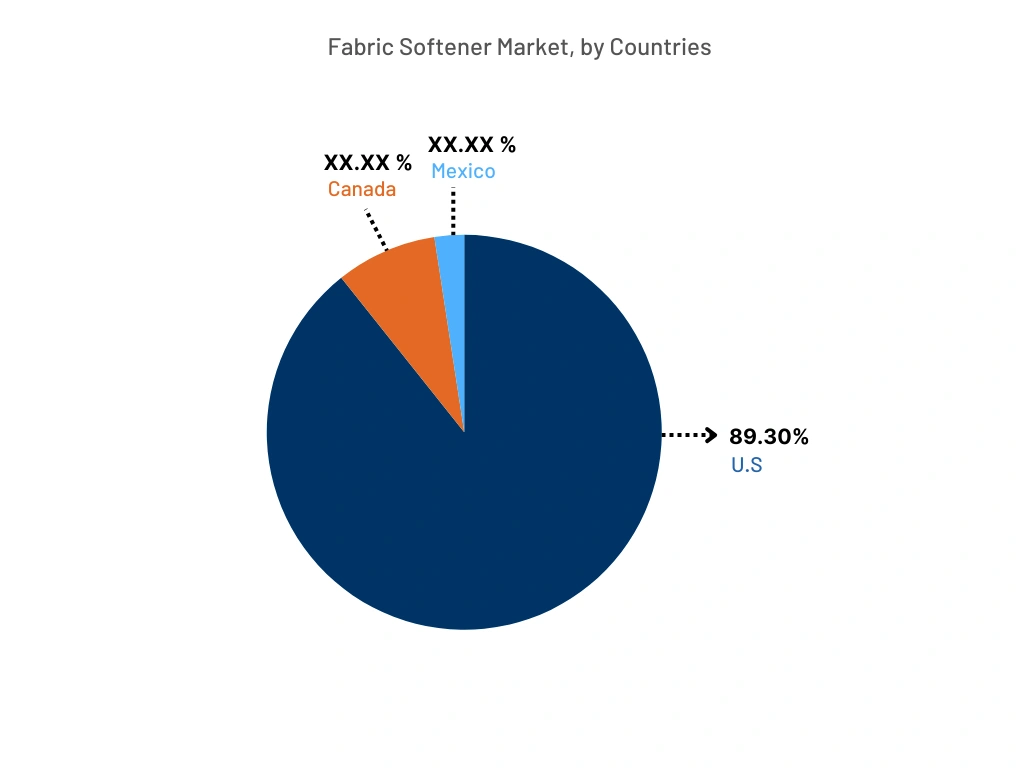
Top Key Players & Market Share Insights :
The fabric softener market is highly competitive, with several large players and numerous small and medium-sized enterprises. The major companies operating in the fabric softener industry have strong research and development capabilities and a strong presence in the market through their extensive product portfolios and distribution networks. The market is characterized by intense competition, with companies focusing on expanding their product offerings and increasing their market share through mergers, acquisitions, and partnerships. The key players in the market include-
- Unilever
- AlEn USA LLC
- RECKITT BENCKISER GROUP PLC.
- PROCTER & GAMBLE COMPANY
- Church & Dwight Co., Inc.
- Devan Chemicals
- HENKEL AG & CO. KGaA
- MARICO LTD.
- PIGEON CORPORATION
- COLGATE PALMOLIVE COMPANY
Recent Industry Developments :
- In July 2022, Unilever launched its most powerful and sustainable laundry capsule. The capsule's GHG emissions are reduced by 16% and are packaged in a plastic-free, cardboard container.
- In May 2021, textile innovator, Devan Chemicals added two products to its range of bio-based textile finishes such as bio-based softener and quick dry finish. The products are derived from vegetable oils and mark a sustainable drive from the company point of view.
Key Questions Answered in the Report
What was the market size of the fabric softener industry in 2024? +
In 2024, the market size of fabric softener was USD 20,448.32 million.
What will be the potential market valuation for the fabric softener industry by 2031? +
In 2031, the market size of fabric softener will be expected to reach USD 26,922.34 million.
What are the key factors driving the growth of the fabric softener market? +
Increasing demand for laundry care products is fueling market growth at the global level.
What is the dominating segment in the fabric softener market by product type? +
In 2024, the liquid segment accounted for the highest market share of 57.28% in the overall fabric softener market.
Based on current market trends and future predictions, which geographical region is the dominating region in the fabric softener market? +
North America accounted for the highest market share in the overall fabric softener market.
